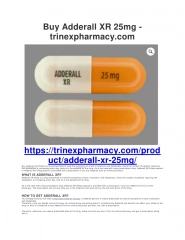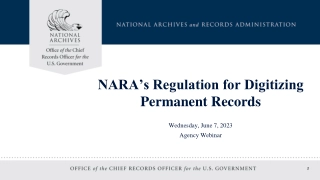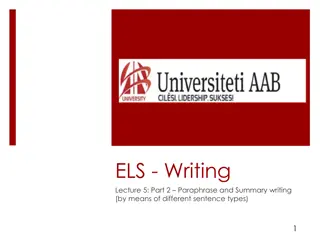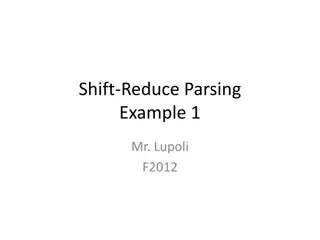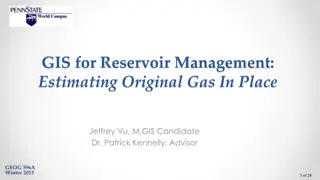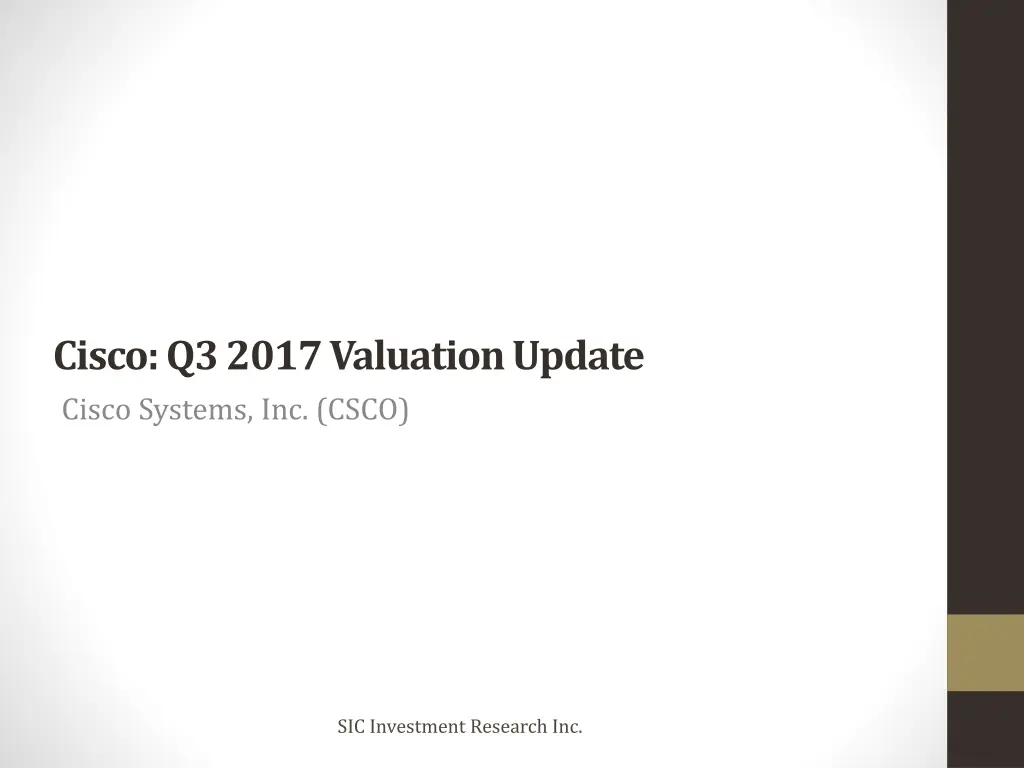
Cisco Q3 2017 Valuation Update: Highlights, Guidance, and Analysis
Explore the Q3 2017 highlights, Q4 2017 guidance, DCF operating assumptions, valuation analysis, and free cash flow assumptions for Cisco Systems, Inc. Despite conservative assumptions, the implied value of Cisco suggests a strong buy recommendation with significant upside potential.
Download Presentation

Please find below an Image/Link to download the presentation.
The content on the website is provided AS IS for your information and personal use only. It may not be sold, licensed, or shared on other websites without obtaining consent from the author. If you encounter any issues during the download, it is possible that the publisher has removed the file from their server.
You are allowed to download the files provided on this website for personal or commercial use, subject to the condition that they are used lawfully. All files are the property of their respective owners.
The content on the website is provided AS IS for your information and personal use only. It may not be sold, licensed, or shared on other websites without obtaining consent from the author.
E N D
Presentation Transcript
Cisco: Q3 2017 Valuation Update Cisco Systems, Inc. (CSCO) SIC Investment Research Inc.
Table of Contents 1. Q3 2017 Highlights 2. Q4 2017 Guidance 3. DCF Operating Assumptions 4. DCF Valuation 5. Analysis 6. Appendix Free cash flow assumptions Terminal growth and discount rate
Q3 2017 Highlights Revenue of $11.94 billion vs. $11.89 billion expected; -0.5% Y/Y. Adjusted revenue (GAAP revenue + deferred revenue) of $11.92 billion, - 0.1% Y/Y. Adjusted EPS of $0.60 vs. $0.58 expected; +5.26% Y/Y. Deferred revenue of -$19 million vs. -$62 million in Q3 2016. Adjusted operating margin [operating income excluding one-time items / (GAAP revenue + deferred revenue)] of 27.0%, vs. 24.6% Q3 2016.
Q4 2017 Guidance Revenue decline of -4% to -6% Y/Y. Non-GAAP operating margin of 29.5% - 30.5%. Non-GAAP tax rate of 22%. Non-GAAP EPS of $0.60 - $0.62.
DCF Operating Assumptions Adjusted revenue decline of 5% in year 1, no revenue growth from year 2 to year 10. Adjusted operating margin of 29.0% for the next 10 years. Net capital expenditure margin of 0.0% for the next 10 years. Net working capital (excluding unearned revenue) margin of 2.7% for the next 10 years. Tax rate gradually increasing from 20% to the highest marginal tax rate of 35%.
Analysis Despite highly conservative operating assumptions, the implied value of Cisco is still 15% higher than its current market price. This valuation suggests a very high margin of safety along with a significant upside should future results exceed the current conservative assumptions. Recommend strong buy.
Appendix: Free Cash Flow Assumptions Unearned revenue is added to GAAP revenue to arrive at the adjusted revenue, which more accurately reflects the company s actual sales results in a period. All margins are calculated based on the adjusted revenue. Share-based compensation is assumed to be a cash expense and is not added back to free cash flow due to the dilutive effects of future share- based compensation on equity value. Deferred tax is not added back to free cash flow as it represents mandatory future cash outflows.
Appendix: Terminal Growth and Discount Rate Terminal growth rate is assumed to be the current 10-year US treasury rate. For reasons why the long-term risk-free rate is used, see Aswath Damodaran s explanations on forecasting terminal value. Discount rate is calculated as 10-year US treasury rate + implied equity risk premium; discount rate is not adjusted by beta. For reasons why beta is not used to adjust the discount rate, see Warren Buffett s comments on discount rate and beta. Implied equity risk premium is assumed to be the trailing 12-months implied equity risk premium with adjusted payouts. For reasons why this rate is used, see Aswath Damodaran s explanations on equity risk premium.


